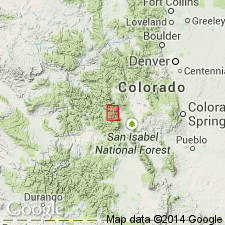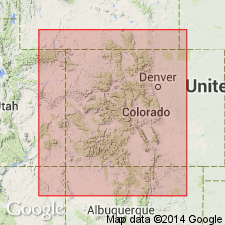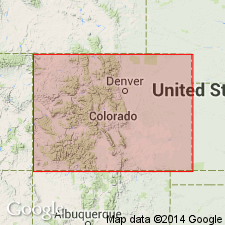
- Usage in publication:
-
- Denny Creek Granodiorite Gneiss*
- Modifications:
-
- Original reference
- Dominant lithology:
-
- Granodiorite
- Quartz diorite
- AAPG geologic province:
-
- Eagle basin
- Piceance basin
Summary:
Pg. A23-A25. Denny Creek Granodiorite Gneiss. Gneissic biotite granodiorite and biotite-quartz diorite. Medium to dark gray, well foliated, and consists of lenticular single grains and aggregates of medium- to coarse-grained plagioclase and quartz and, also augen of pale-pink microcline perthite; grains, aggregates, and augen are set in a continuous schistose matrix of fine-grained biotite that, in addition, commonly contains either hornblende or muscovite. Intruded by Browns Pass Quartz Monzonite (new) and Kroenke Granodiorite (new). Part of rock assigned to Denny Creek was called Pikes Peak Granite by Stark (1935) and Stark and Barnes (1935, Colorado Sci. Proc., v. 13). Age is Precambrian.
Type area: along Denny Creek at altitudes of 10,800 to 11,000 ft, Mount Harvard quadrangle, Chaffee and Gunnison Cos., central CO. Forms batholith that extends beyond boundaries of quadrangle. Named from Denny Creek.
Source: Publication; US geologic names lexicon (USGS Bull. 1350, p. 204).

- Usage in publication:
-
- Denny Creek Granodiorite*
- Modifications:
-
- Areal extent
- AAPG geologic province:
-
- Southern Rocky Mountain region
Summary:
Pg. D2 (fig. 1), D6, D12. Denny Creek Granodiorite. Batholithic body recognized in central Sawatch and Mosquito Ranges, [Chaffee and Gunnison Counties], central Colorado. Includes rock in Mosquito Range mapped as Pikes Peak Granite by Stark and Barnes (Colorado Sci. Soc. Proc., v. 13, no. 8, p. 467-479, 1935) and as Trout Creek Augen Gneiss by Hutchinson (24th Intl. Geol. Cong. Proc., no. 24, p. 201-212, 1972). Age is considered Precambrian X, about 1,700 Ma. Probably of similar age as Cross Creek Granite (=1,715 Ma, citing C.E. Hedge, written commun., 1973). Older than Kroenke Granodiorite (=1,700 Ma, citing Barker and others, 1974, USGS Jour. Research, v. 2, no. 6, p. 705-709).
(See Brock and Barker, 1972, USGS Geol. Quad. Map GQ-952; Scott, 1975, USGS Misc. Field Studies Map MF-657.)
Source: Publication.

- Usage in publication:
-
- Denny Creek Granodiorite*
- Modifications:
-
- Overview
- AAPG geologic province:
-
- Eagle basin
- Piceance basin
Summary:
Is one of nine formally named lithodemic units assigned to Routt Plutonic Suite of Early Proterozoic age (a new name). Extends from west edge of Sawatch Range to mountain front northeast of Canon City in Southern Rocky Mountain region, CO. Is a gneissic granodiorite batholith. Is medium to dark gray, coarse grained, well foliated, and contains unevenly distributed augen of pale-pink microcline perthite. Where microcline abundant, rock grades to quartz monzonite; where microcline sparse, grades to biotite quartz diorite. Was intruded by Kroenke Granodiorite. Locally, names Pikes Peak Granodiorite and Trout Creek Augen Gneiss were applied to rocks now called Denny Creek. Is about same age as Cross Creek Quartz Monzonite and Boulder Creek Granodiorite.
Source: GNU records (USGS DDS-6; Denver GNULEX).
For more information, please contact Nancy Stamm, Geologic Names Committee Secretary.
Asterisk (*) indicates published by U.S. Geological Survey authors.
"No current usage" (†) implies that a name has been abandoned or has fallen into disuse. Former usage and, if known, replacement name given in parentheses ( ).
Slash (/) indicates name conflicts with nomenclatural guidelines (CSN, 1933; ACSN, 1961, 1970; NACSN, 1983, 2005, 2021). May be explained within brackets ([ ]).

